TheRoundup is reader supported. We may earn a small commission when you make a purchase via links on this site, at no cost to you.
All products are personally reviewed and tested in accordance with our Review Methodology.

Are you tired of using cutting boards that expose your food to harmful chemicals?
Most people don't realize their food chopping board might contain BPA, microplastics, or even formaldehyde.
Some also trap harmful bacteria, while others can damage your expensive kitchen knives.
I'm the regular chef in our house and I chop food daily. So I set out to research and test the safest non-toxic cutting boards guaranteed to be eco-friendly, durable, and high-performing.
I've compiled a list of the best cutting board options on the market. You'll love them because they tick all the boxes and are affordable too...

✔ Keeps Knives Sharp
✔ Deep Juice Trench (Reduces Mess)
✔ Natural Materials
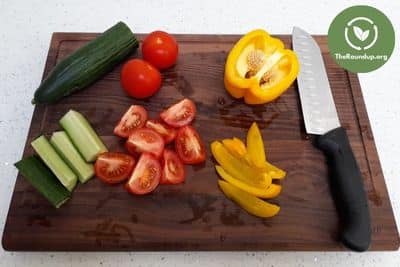
Why It's My #1 Pick: This stunning walnut cutting board is my #1 pick because it was the best all-rounder during testing.
The Amercian black walnut is robust and knife-friendly.
I was also impressed by the multifunctional design. It doubles as a beautiful serving platter.
Personal Experience: This is the best cutting board I've ever used. It's definitely a keeper!
The weight and thickness are just right for a stable surface. This is reassuring when working with larger or tougher ingredients.
The thoughtful juice trench design saved me from countless spills and cleanup sessions and made my cooking prep process much smoother.
I also use this board to serve snacks and appetizers during gatherings. Guests always comment on its beauty, and it often becomes a conversation piece.
The board came pre-treated with two coats of food-grade mineral oil. This was fine (it's non-toxic). However, I prefer to use coconut oil on all my wooden kitchen utensils. So, straight out of the box, I thoroughly washed it in warm, soapy water and allowed it to air dry.
I then applied a generous oil coating and let it soak in for three hours. This helped protect the board further and enhance the natural beauty of the wood grain.
About the Brand: You can read my detailed thoughts on the brand in my Our Place Review article.

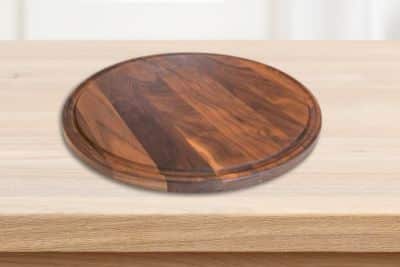
Why It's My Recommended Round Cutting Board: Most of the competition's round boards were made from thinner, cheaper wood that felt flimsy. However, this board is made from durable American walnut wood and excelled in every test.
Personal Experience: The quality was evident when I unpacked this round cutting board. The rich, dark tones of the walnut wood and the smooth finish were striking.
The first test was when I used it for a wine and cheese night. It was an instant hit. The board provided plenty of space for various cheeses, fruits, and nuts. The juice groove worked perfectly, catching stray liquids and keeping the table clean.
This board is not just a pretty face, though. The sturdy American walnut wood also stood up to heavy chopping and food prep during testing.
This round board will last years with a bit of love and care (handwashing only and regular oiling).
About the Brand: Virginia Boys Kitchens is a family-run business. They're committed to quality, sustainability, and community values.
Despite the name, the company prides itself on being inclusive and diverse. It has a deep love for wood, particularly walnut, which it uses to craft beautiful, high-quality kitchenware.
All Virginia Boys Kitchens products are locally made to support local economies. This also eliminates the ecological footprint of overseas shipping.

✔ Lifetime Warranty
✔ Withstands Temperatures up to 350°F
✔ Made in the USA
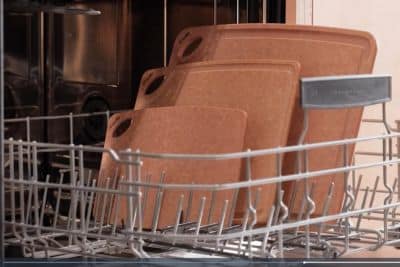
Why It's My Recommended Dishwasher-Safe Cutting Board: Most of the dishwasher-safe cutting boards I tested were made from plastic. And some of the composite ones were made with questionable materials and toxic glues.
However, I was very impressed with this board from Elihome. It's non-porous, made from high-density pine leaf fiber wood, and certified non-toxic by NSF International.
Personal Experience: I was impressed by this cutting board's versatile design during testing. It performed brilliantly in all types of food preparation.
I was equally impressed by the non-porous surface. It didn't absorb odors or stains, even after cutting garlic and beets.
This is also the largest board I'm recommending. If you need a large surface area, this could be the board for you.
However, cleaning is where this cutting board excelled. After each test session, I popped it in the dishwasher, and it came out looking as good as new every time!
About the Brand: Elihome has over thirty years of experience in the global kitchen and housewares business.

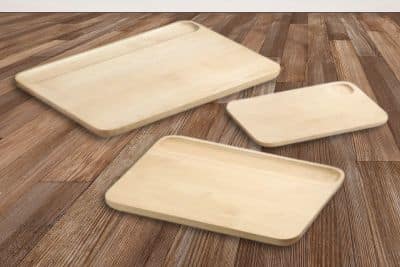
Why It's My Recommended Cutting Board Set: Most of the sets I tested for this article were either poor quality or very expensive. But this set from Caraway was different.
It's made from high-quality FSC-certified birch wood which is both sustainable and durable.
The set includes three sizes catering to a wide range of kitchen needs. During my tests, whether chopping vegetables, slicing bread, or preparing meat, there was a board that fit the task perfectly.
Personal Experience: The first thing I noticed during testing was the quality of the birch wood. The boards felt solid and well-made, with a smooth finish that was gentle on my knives.
Having three sizes to test was incredibly useful. It allowed me to switch between tasks without repeatedly washing the boards.
I loved the inclusion of a storage organizer. It kept the boards upright and air-dried. So they remained in excellent condition and I saved counter space.
The boards are finished with food-safe mineral oil and wax. However, as with the Our Place board, I thoroughly washed all three boards in hot, soapy water. I then applied a generous coating of coconut oil to keep it it top condition.
About the Brand: Caraway focuses on making non-toxic, eco-friendly products for home cooks.
Every Caraway product I've ever tested has been shipped in plastic-free, recyclable packaging.


Why It's My Recommended Single-Piece Board: The cherry wood used is robust, with a beautiful grain pattern. It was the most visually appealing of all the single-piece wood boards I tested.
The homemade beeswax and organic coconut oil polish also set it apart from the competition. It protected the wood and gave it a rich, warm glow.
Personal Experience: The first thing that struck me about this cutting board during testing was its weight and stability. Both immediately gave me a feeling of durability.
The board performed exceptionally well. It provided a stable, non-slip surface for chopping. Its size is perfect for both small and large tasks.
The board was easy to clean in hot, soapy water. I found the added care instructions helpful for keeping it in good condition. However, because this is a solid piece of wood, you do have to be extra careful to dry it thoroughly to prevent warping and cracking.
About the Brand: Adirondack Kitchen has a history of fine woodworking.
It uses locally sourced wood and organic finishes. The brand also prides itself on its plastic-free packaging, using kraft paper instead.
I rigorously tested every recommendation in this article across extensive criteria.
Here's how I approached testing to ensure that every board was the best option for your specific needs.
Switching to non-toxic cutting boards is one of the simplest ways to make your kitchen a healthier and greener place.
Non-toxic wood boards will keep your food chemical-free and reduce your carbon footprint.
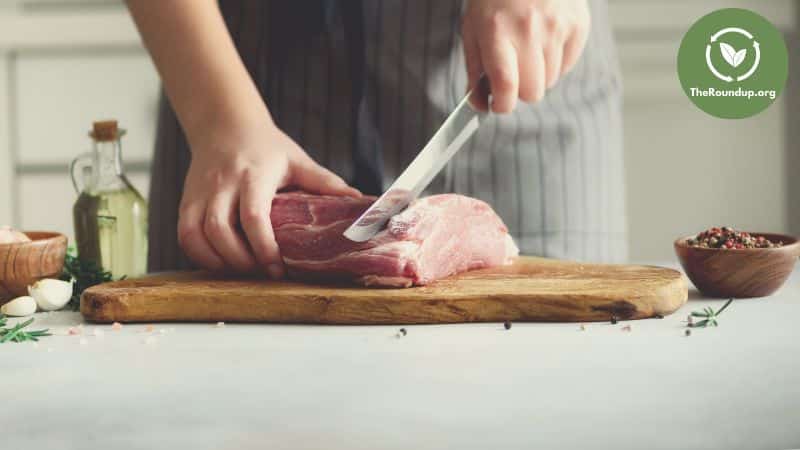
Verdict: Safe
Hardwood cutting boards are a traditional favorite and the only type I use. I love them for their durability, natural beauty, and knife-friendly surfaces.
You either get a board made from a single piece of wood or pieces of wood glued together.
A single piece is often considered superior. However, without extra care, it can warp and crack.
I prefer cutting boards made from large pieces of sustainable wood glued with non-toxic, food-safe glue. This usually results in a stronger and more warp-resistant board.
Verdict: Avoid
Plastic boards are popular for their affordability, lightweight nature, and ease of cleaning.
They come in various colors and are often dishwasher-safe.
But they are bad for the environment and can contain chemicals.
Verdict: Safe only if Certified
Composite boards blend natural fibers with resins to create durable, eco-friendly surfaces.
Epicurean cutting boards use paper-resin composites.
Bamboo cutting boards are usually made from strips of bamboo that are glued and pressed together.
Verdict: Safe
Glass and ceramic cutting boards are sleek and non-porous, making them popular for their hygienic surfaces.
They're also stain-resistant and easy to clean.
Verdict: Safe only if made from Natural Rubber
Rubber cutting boards offer a flexible, resilient surface.
They're often used in commercial kitchens because they're durable and easily resurfaced.
Verdict: Safe but not great for the environment
Silicone cutting boards are soft and flexible, allowing them to be easily folded or stored.
Their non-slip surface is particularly helpful in the kitchen.
Verdict: Safe
Stainless steel cutting boards are durable, sleek, and often used in professional kitchens.
They are rust-resistant and can handle heavy-duty chopping.
For a more detailed look at the potential toxicity of stainless steel, check out my non-toxic cookware article.
Verdict: Safe but not eco-friendly
Marble and granite cutting boards are luxurious, non-porous, and suitable for rolling out dough.
Their cool surfaces also make them excellent for working with chocolate or pastry.
Maple is a popular choice because of its tight grain structure and high density. Both of which make it resistant to moisture absorption and less prone to staining.
It's also relatively inexpensive and has a neutral appearance. A good quality maple cutting board will complement any kitchen.
Walnut is softer than maple but still provides a durable cutting surface that's gentle on knives.
Its dark color and attractive grain pattern make it a stylish and sophisticated option.
Teak wood is known for its natural oils and moisture resistance. It's highly durable and can withstand heavy use.
The natural oils also give it a high resistance to mold and bacteria. Perfect for a cutting board material.
Cherry is a medium-density hardwood. It offers a gentle cutting surface.
Its fine grain structure makes it resistant to moisture. Over time, its rich reddish-brown hue develops a beautiful patina.
Rubberwood is a renewable resource. It's harvested from rubber trees after they stop producing latex.
This type of wood is dense, durable, and resistant to staining or warping.
The basic care and maintenance tips for any cutting board are simple:
However, caring for a non-toxic wooden cutting board takes slightly more effort, but it's worth it!
Cleaning your cutting board is not always enough. Occasionally, sanitize the board to kill any lingering bacteria.
Mix a solution of one part white vinegar to four parts water and wipe down the board's surface.
Let it sit for a few minutes before rinsing off with warm water and drying thoroughly.
Sprinkle coarse salt or baking soda on the board, then rub it with half a lemon to scrub away stains or odors.
Rinse with warm water and dry thoroughly.
After cleaning, dry your board immediately with a clean towel to prevent moisture absorption.
Store it upright or in a well-ventilated rack to allow airflow around it. This keeps the board dry and reduces the risk of mold growth.
The best oils for non-toxic cutting boards are coconut oil, linseed oil, or beeswax. You should apply them every 2-3 weeks.
Pour a small amount onto the board, then spread evenly with a clean cloth.
Allow the oil to soak in overnight and wipe away any excess in the morning.
Using the right tools on your cutting board can significantly extend its lifespan.
Always use sharp knives, as dull blades can cause more damage to the board's surface.
Avoid using electric knives or heavy cleavers on wooden boards. These can create deep cuts and grooves that are harder to repair.
Avoid placing hot pots or pans on the board. The heat can weaken the wood fibers and lead to damage.
Use both sides of the board for cutting tasks to distribute the wear evenly.
Over time, even the best-cared-for cutting boards can develop grooves and cuts. When this happens, it's essential to resurface the board to maintain a smooth, safe cutting surface.
Use fine-grit sandpaper to gently sand down the surface. After sanding, clean the board thoroughly and apply a fresh coat of oil to restore its protective finish.
Edge-grain boards are made by gluing long strips of wood together, with the grain running parallel to the surface.
End-grain cutting boards are constructed by gluing the ends of the wood strips together, creating a checkerboard pattern on the surface.
Potentially, yes. The Environmental Protection Agency (EPA) has raised concerns about triclosan and its potential toxicity.
Avoid cutting boards made from materials that may contain harmful chemicals or toxins, such as plastic and antibacterial coatings.
Choosing a non-toxic cutting board is vital to prevent harmful glues and coatings from leaching into your food.
In this article, I've detailed the best options. I've also highlighted their safety, durability, and environmental benefits.
My #1 pick is the stunning Our Place Walnut Cutting Board.
However, every recommendation in this article will help keep harmful chemicals out of your food prep area. All while supporting sustainable manufacturing.
Happy non-toxic cooking!

Our core values mean we always prioritize sustainability over profit. We carefully evaluate and personally test every product to ensure they meet our high standards. All products recommended in this article were tested in accordance with our Review Methodology.
TheRoundup.org - As Seen On
